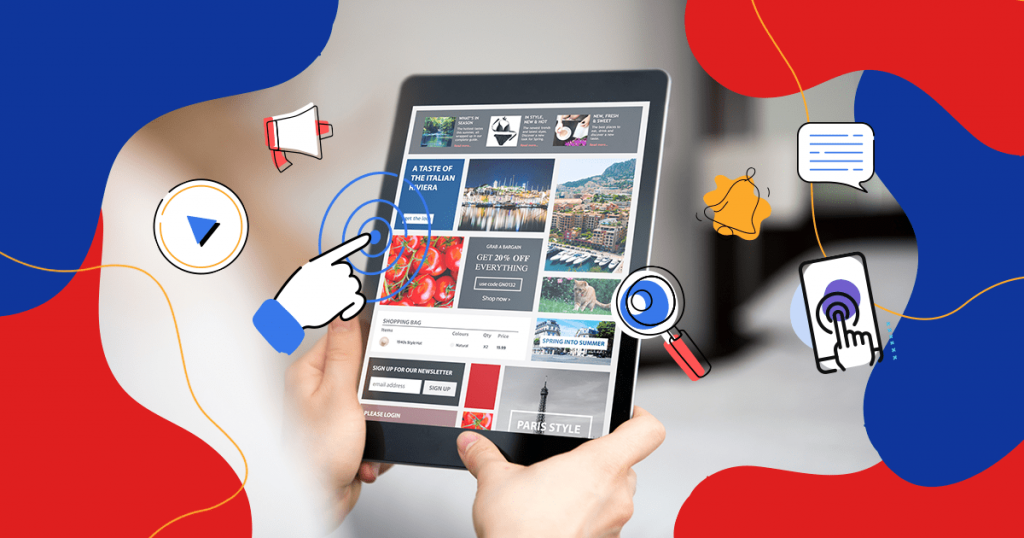Strategizing and creating digital advertising campaigns for your brand can be time-consuming and even a bit daunting.
Yet, advertising campaigns can excel at reaching targeted audiences, providing you with valuable customer insights, and even lead to an increased ROI.
With a growing importance being placed on social media today, agencies are forced to determine new ways to find and connect with relevant audiences.
Knowing where to place ads for maximum effectiveness, however, continues to be a challenge for most brands.
Even just one mistaken placement can be disappointing and costly as well.
Fortunately, you can now target audiences more precisely with the aid of AdTech, which allows you to buy, manage, and measure your digital advertising efforts.
Fueled by influential data, AdTech helps you make those wiser ad placements where and when they are most needed to reach your intended audience.
Include its use in your digital marketing strategy, and soon you may find yourself gaining an appreciation for AdTech’s capabilities to maximize all your digital advertising campaigns.
Here’s everything about AdTech you need to know to get started.
- What is AdTech?
- Advantages of Advertising Technology
- How Does AdTech Work?
- 10 AdTech Technology Trends That You Need to Know
- Wrap Up: Ready to Rock your Ad Performance?
What is AdTech?
AdTech, or Advertising Technology, is an inclusive term for the various tools, software, and technologies different brands and advertisers utilize to:
- Plan and optimize advertising campaigns.
- Target and reach intended audiences.
- Deliver digital advertising campaigns.
- Measure and analyze results of those digital advertising campaigns.
- Make better use of advertising budgets.
AdTech provides ways to streamline your process for buying and selling digital ads.
It allows for the full range of necessary actions, from choosing a particular subject for your ad to efficiently positioning it to selecting the targeted recipients.
Advantages of Advertising Technology
AdTech is not a one-ad-fits-all solution to advertisement placement.
Instead, it offers a variety of ways for brands, and even agencies, to stand out and set themselves apart from the competition.
What are the advantages of creating a strategy utilizing AdTech?
Allows for More Efficient Use of Advertising Budgets
All companies want to get the most out of their advertising budget, so finding ways to do just that is imperative to maximizing the return on investment (ROI).
By utilizing Advertising Technology, agencies and advertisers can better deliver the right content at the right times to ideal audiences. And this can lead to a higher number of conversions.
This differs from traditional methods for media buying and delivery, where ad placement and inventory are not as controllable.
Essentially, AdTech is here to help marketers and advertisers better allocate their budgets and see more successful targeted outcomes.
Facilitates Better Campaign Monitoring
Advertisers and agencies, with the aid of AdTech, have access to superior planning options and measurement tools to aid in campaign monitoring and tracking.
Certain tools provide information on a campaign’s performance from various perspectives, which can be extremely helpful.
For instance, are the ads performing better on one placement location than all others?
This ability leads to better measuring of campaigns, allowing for advertisers to optimize more effectively now and in the future.
Ensures Cross-Platform Uniformity
With the use of Advertising Technology, advertisers can ensure cross-platform uniformity, meaning functionality across platforms will be identical or as close to it as possible.
This ensures that your brand is being represented correctly and is reaching consumers in a consistent and logical manner.
Also, all advertising channels are connected, with the additional benefit of being able to manage integrated campaigns more effectively.
Provides Insights for Reaching Customers Along Their Buyer’s Journey
Consumers exist at different stages of the buyer’s journey, or marketing funnel, thus requiring different approaches.
AdTech provides informative insights, providing brands with the opportunity to refine and optimize how they reach their audiences along these different stages.
How Does AdTech Work?
Advertising Technology is designed to assist both advertisers and publishers perform more efficient and successful media deal exchanges with the use of programmatic algorithms.
To understand how AdTech works, you will need to know the key players, the most commonly used methods, and the common tools available to simplify and improve digital ad campaigns.
#1. Key Players
To understand more of whom the key players are, here is a basic breakdown of the demand side (advertisers) and the supply side (publishers).
Advertisers
The advertiser utilizes this technology to increase the effectiveness of advertising budgets and ensure that their ad campaigns are reaching their intended audience.
In addition, advertisers measure metrics of their campaigns, including ROI, collect customer insights, and adapt campaigns based on these metrics and insights.
AdTech helps by making it easier to develop a full-funnel marketing strategy utilizing programmatic software and collected customer insights.
Publishers
The publisher, on the other hand, caters to the demands of advertisers by configuring inventory to satisfy their requirements.
Publishers and their various resellers generate revenue with their digital assets, placing ads and measuring engagement and other useful data.
Together, the advertiser and publisher create a loop of supply and demand, which is available due to the valuable user data collected on these various platforms.
#2. Common Methods
Two valuable methods within AdTech are programmatic advertising and omnichannel marketing.
Programmatic advertising
It involves reaching specific target audiences. This type of media buying ensures advertising budgets are used efficiently and not wasted on consumers unlikely to convert.
Omnichannel marketing
It involves technology for reaching customers wherever they are, including on mobile devices, desktops, video, and so forth.
It is a method for seamlessly integrating branding and messaging, along with both online and offline touchpoints to meet customers where they are along the sales funnel.
By utilizing AdTech, marketers can ensure that digital advertising campaigns match with other forms of marketing consistently across platforms.
#3. Common AdTech Tools
One way to become more familiar with how Advertising Technology works is by knowing the most commonly used tools.
Demand-Side Platforms (DSPs)
Demand-Side Platforms allow advertisers to purchase ad placements in real-time and at optimized prices.
These ad placement options include search, video, display, and mobile platforms.
Essentially, marketers use DSPs to access a variety of ad inventory within a single window.
The benefit of this is that they avoid having to reach out to individual publishers, saving them valuable time in implementing their digital advertising strategy.
Examples of DSPs include SmartyAds, Simpifi, DoubleClick Bid Manager, Adobe Media Optimizer DSP, and AppNexus.
Supply-Side Platforms (SSPs)
Supply-Side Platforms provide publishers with a way to understand real-time demand for their various ad slots.
From here, they can also manage ad inventory and establish ways to earn revenue.
Essentially, SSPs are where ad inventory is consolidated, resulting in a way for publishers to determine minimum prices and communicate with DSPs.
Examples of SSPs include OpenX, MoPub, AppNexus Publisher SSP, AerServ, Google Ad Manager.
Agency Trading Desks (ATD)
Agency Trading Desks are services offered by media agencies to help brands plan, buy, and manage their ads across the various available platforms.
They are simplified versions of DSPs for those advertisers just starting out and not yet ready to go all-in with the help of the bigger Demand-Side Platforms.
Ad Servers
Ad Servers are applications that automate ad placement, then display them on various websites. They also collect performance data for each ad.
Examples include OpenX Ad Server, Atlas, DoubleClick for Publishers (DFP), AdButler, adColt Ad Server.
Ad Networks
Ad Networks serve as the go-between for advertisers and publishers.
Their goal is consolidating ad inventory from various publishers and giving advertisers a range of choices for their strategic needs.
Perhaps you will choose to gain insights about your ideal buyers, then select from the inventory provided by an ad network, such as Rocket Fuel, Baidu, InfoLinks, Taboola, or Google DoubleClick Ad Exchange.
Utilizing one of these Ad Networks offers a way for heightened optimization of your digital advertising efforts.
Obviously, there are more than one or two ways to go about using Advertising Technology, but knowing some of the tools available can help you get started and learn more about what will work best for your brand as you go along.
10 AdTech Technology Trends That You Need to Know
AdTech continues to improve and evolve along with digital marketing strategies. Trends to keep an eye out for in this area include the following.
1. The Move Towards Consolidation
Advertising Technology continues to expand and grow, reaching into new territories and platforms. This attracts more attention, especially from larger corporations.
A trend shows that larger AdTech corporations are moving towards consolidation of companies within respective niches.
This is a way for them to not only strengthen but also scale the level of options they can offer.
Soon publishers and advertisers may be able to go to one or two of these platforms to fulfill many if not all of their digital advertising campaign needs.
2. Niche Product Offerings
While larger corporations will dominate the AdTech market, smaller startups will arrive on the scene and cater to more niche product offerings.
Options beyond Facebook and Google may soon be available as a result, reaching consumers by way of native advertising options and various new platforms and apps.
3. Increasing Transparency
Components of the AdTech supply chain are expected to become more transparent to publishers, advertisers, and the end-users alike.
Publishers will be pushed to disclose their methods of consumer data collection and how it is analyzed or used.
4. Mobile Growth
The popularity and use of mobile devices for researching and consuming information continue to rise.
With the important characteristics of portability and convenience, mobile devices are always on hand and a huge opportunity for increasing digital ad revenue.
As a result, AdTech is adapting and targeting in on ways to advertise better on these popular mobile devices.
5. New Ad Channels
Reaching consumers means staying informed of various ad channels becoming available, such as Smart TVs and OTT (over-the-top) platforms like Hulu, Netflix, and Amazon Prime.
These OTT media services are offered to consumers directly over the internet, eliminating the need for the more traditional cable or satellite tv platforms, once the controllers of ad buying.
Expansion of AdTech options for these new ad channels will increase in the years ahead.
Other ad channels on the radar of AdTech companies include DOOH (digital out-of-home) and DTC (direct-to-consumer) brands.
6. Storytelling Through Ads
Advertisers, through their ads, will begin telling more compelling stories to reach their audience, leading to more meaningful customer interactions with their brand.
While designs, colors, and aesthetics may first draw the eyes of consumers, it’s the message and story surrounding it that needs to emotionally connect with consumers to make ads more efficient and effective.
This storytelling may be accomplished through emphatic marketing methods and possibly even immersive experiences such as Augmented and Virtual Reality.
7. Offering More Self-Service Options
A new trend in Advertising Technology is the introduction and adoption of newer technologies to increase self-service options.
Advertisers will have more control over their time and choices by working through these self-service options and managing advertising campaigns from them as well.
8. Artificial Intelligence (AI) Aided AdTech
As programmatic advertising continues to grow in importance, the overall process will move toward utilizing automated AI technology.
With AI, the ad purchasing process can be automated, allowing advertisers to target intended audiences.
Automation measures will continue to grow in popularity, and the use of AI will be able to make adjustments in real-time across the various channels and platforms.
9. Automation Header Bidding
Header bidding, an automated auction technology, facilitates publishers’ receipt of bids from numerous advertisers at the same time.
This process showcases the level of demand and can lead to reasonable base prices for advertisers, making it a popular option for growth.
10. MAdTech
MAdTech is the convergence of marketing technology (MarTech) and advertising technology (AdTech) and is one trend to be on a special lookout for in the years ahead.
Both technologies utilize customer data and can work together.
Analyzing MarTech customer insights can lead to better ways of identifying and purchasing digital ads through AdTech, making them a powerful combination for digital marketing strategies.
Wrap Up: Ready to Rock your Ad Performance?
AdTech will continue to evolve and offer brands increasingly efficient and effective ways to reach their target audiences.
Meanwhile, you can leverage the current capabilities of this rising technology to optimize your advertising campaigns and make better use of budgets, a win-win any way you look at it.
For more ways to increase the performance of your ads, request a Rock Content demo today.










